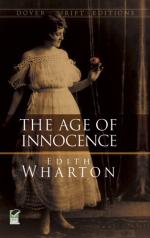“Well—upon my soul!” exclaimed Lawrence Lefferts, turning his opera-glass abruptly away from the stage. Lawrence Lefferts was, on the whole, the foremost authority on “form” in New York. He had probably devoted more time than any one else to the study of this intricate and fascinating question; but study alone could not account for his complete and easy competence. One had only to look at him, from the slant of his bald forehead and the curve of his beautiful fair moustache to the long patent-leather feet at the other end of his lean and elegant person, to feel that the knowledge of “form” must be congenital in any one who knew how to wear such good clothes so carelessly and carry such height with so much lounging grace. As a young admirer had once said of him: “If anybody can tell a fellow just when to wear a black tie with evening clothes and when not to, it’s Larry Lefferts.” And on the question of pumps versus patent-leather “Oxfords” his authority had never been disputed.
“My God!” he said; and silently handed his glass to old Sillerton Jackson.
Newland Archer, following Lefferts’s glance, saw with surprise that his exclamation had been occasioned by the entry of a new figure into old Mrs. Mingott’s box. It was that of a slim young woman, a little less tall than May Welland, with brown hair growing in close curls about her temples and held in place by a narrow band of diamonds. The suggestion of this headdress, which gave her what was then called a “Josephine look,” was carried out in the cut of the dark blue velvet gown rather theatrically caught up under her bosom by a girdle with a large old-fashioned clasp. The wearer of this unusual dress, who seemed quite unconscious of the attention it was attracting, stood a moment in the centre of the box, discussing with Mrs. Welland the propriety of taking the latter’s place in the front right-hand corner; then she yielded with a slight smile, and seated herself in line with Mrs. Welland’s sister-in-law, Mrs. Lovell Mingott, who was installed in the opposite corner.
Mr. Sillerton Jackson had returned the opera-glass to Lawrence Lefferts. The whole of the club turned instinctively, waiting to hear what the old man had to say; for old Mr. Jackson was as great an authority on “family” as Lawrence Lefferts was on “form.” He knew all the ramifications of New York’s cousinships; and could not only elucidate such complicated questions as that of the connection between the Mingotts (through the Thorleys) with the Dallases of South Carolina, and that of the relationship of the elder branch of Philadelphia Thorleys to the Albany Chiverses (on no account to be confused with the Manson Chiverses of University Place), but could also enumerate the leading characteristics of each family: as, for instance, the fabulous stinginess of the younger lines of Leffertses (the Long Island ones); or the fatal tendency of the Rushworths to make foolish matches; or the insanity recurring in every second generation of the Albany Chiverses, with whom their New York cousins had always refused to intermarry—with the disastrous exception of poor Medora Manson, who, as everybody knew . . . but then her mother was a Rushworth.




